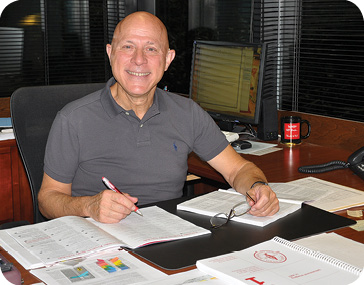In 1978, “test tube baby” Louise Joy Brown became the first person born through the use of in vitro fertilization (IVF). Since then, the number of babies delivered with help from IVF or other assisted reproductive technology (ART) totaled about 2.5 million worldwide as of 2007, with another 2.5 million born through 2013, according to the International Committee for the Monitoring of Assisted Reproductive Technology. Andrew La Barbera, Ph.D., chief scientific officer of the American Society for Reproductive Medicine (ASRM), provided IEEE Pulse with an overview of this quickly growing and evolving field, including reproductive technologies that may soon be available in the clinic.

IEEE Pulse: Before we get into the latest technologies, what exactly does ART cover?
Andrew La Barbera: When we talk about ART, we’re referring to the manipulation of both the male and female gametes outside of the body. Intrauterine insemination, where a man ejaculates sperm and those sperm are then prepared and transferred to a woman’s uterus, would not be considered ART because only one of the gametes, the male gamete, is actually manipulated.
IEEE Pulse: Within ART, what do you see as the most active and intriguing research areas?
La Barbera: I would say there are four areas that have really come to the fore in ART. They are as follows:
- Embryo selection, which means choosing the embryo with the highest chance of achieving live birth. Live birth is the gold standard that we use for considering that a procedure has been successful.
- Accessibility, which means making ART available to anyone who desires conception.
- Fertility preservation, which is preserving the eggs and sperm, especially in people who are undergoing medical treatment that could negatively affect their fertility or for individuals who want to delay childbearing.
- Gamete generation from stem cells, so that people who are not producing eggs or sperm can still have a baby using gametes derived from their own cells.
IEEE Pulse: Let’s talk about embryo selection. What is the issue, and what is happening to improve the odds of live birth through ART?
La Barbera: Embryo selection is one of the hottest areas of research because, when you really get down to it and look at the overall success rate of IVF for all people of all ages, it’s around 35%. We know that age of the female partner is probably the most important predictor of success in IVF: The chances of live birth decline with age, particularly over age 35. However, even using oocytes from women who are in their early- to mid-20s, the success rate is only about 70%. So, how do you pick the best embryo? There are two techniques that are undergoing great investigation right now.
One of them is embryo imaging. This means taking eggs and sperm, mixing them together, putting them in a dish, which then goes into a sealed chamber until the eggs and sperm are transplanted into the uterus. During this process, you use an imaging device that can see when the embryo cells are actually dividing. There’s a hypothesis that the embryos with the greatest chance of developing and resulting in a live birth are those that regularly divide at about once every 24 hours and those that give rise to blastomeres (cells produced by cell division after fertilization of the zygote) that are uniformly shaped and sized. Research groups in Valencia, Spain, and at Stanford University are looking very carefully at the effect of regular cell division using time-lapse imaging morphometry, and another at Brigham and Women’s Hospital in Boston is studying classical morphological assessment or trying to judge the viability of an embryo by its overall appearance.
The other area under consideration for assessing embryos is genomics. Richard Scott of Reproductive Medicine Associates of New Jersey and his group are leading this research and currently doing randomized controlled trials to see whether you can select embryos based on genomic profiling and can ultimately improve success rates. Their results are very promising.
Between imaging and genomic analysis, we are really advancing rapidly in terms of our ability to select the embryo with the highest chance of success. And that’s very important, especially in this country where a couple may have to pay in excess of US$10,000 to undergo one cycle of IVF treatment or other ART treatment. These couples want to have the best possible chance of success.
IEEE Pulse: Speaking of costs, they can obviously limit accessibility. Is there technology involved in improving accessibility and lowering costs?
La Barbera: We think so. There are the methods that are under investigation, such as a very small chamber called a vaginal incubator. Here, you collect eggs and sperm and put them into this chamber that is then implanted into a woman’s vagina so that the embryo development takes place inside a woman’s body rather than in an incubator. The advantage there would be that you wouldn’t need a laboratory with a whole lot of technology, personnel, and quality control for fertilization and incubation of the embryos, and that could possibly reduce the cost of conception tremendously.
IEEE Pulse: A good deal of attention has been placed on sperm and egg banking. What’s new in this arena?
La Barbera: For some time now, laboratories have been freezing embryos, and that technology works fairly well. Today, there’s a lot of research ongoing with regard to the cryopreservation, or freezing, of oocytes and ovarian tissue (see “The Big Chill: Freezing Sperm, Embryos, and Now Eggs” in the article “Babies from Skin Cells?” on page 16 of this issue of the magazine). We’ve been freezing men’s sperm for decades, and for the last 20 years, we’ve really been working on the pediatricians and oncologists to encourage their male patients who are undergoing chemotherapy or radiation therapy to bank their sperm so that when they are finished with their treatment and are cancer-free, they and their partners can still conceive a child.
IEEE Pulse: And the field is now turning to freezing eggs?
La Barbera: Yes. Let’s say a woman is going to undergo cancer treatment, so she comes in, is stimulated with hormones, and undergoes an oocyte retrieval where you collect the oocytes and then cryopreserve them. After the cancer treatment, when the gonadotoxic chemotherapeutic agents are no longer in her system, she can have some of those oocytes thawed and inseminated with her partner’s sperm so they can have a child. This is a very, very important area right now, and a main question is whether vitrification, which is an ultrarapid freezing technique using very high concentrations of a cryoprotectant, is equivalent to or better than an alternate technique where you use lower concentrations of cryoprotectant and freeze the oocytes in a much slower, more gradual way. Vitrification requires a lot of skill to perform, whereas slow freezing doesn’t demand as much skill but requires a lot more expensive equipment.
IEEE Pulse: Work is also under way to freeze segments of ovarian tissue, which could be thawed, matured, and fertilized in vitro, or could be transplanted into the patient. This would be beneficial for prepubescent girls who are undergoing chemotherapy. How is that proceeding?
La Barbera: That’s not as far along, and I don’t believe that has resulted in any live births yet. But that work is continuing.
IEEE Pulse: The last area you mentioned was the generation of gametes from stem cells. Are these from somatic stem cells?
La Barbera: A few years ago, there was some talk that the ovary had stem cells that could give rise to oogonia. That hasn’t really panned out so far, but there is research in both males and females that takes somatic cells and tries to deprogram and then reprogram them to form either ovarian stem cells or testicular stem cells, or what we call germ-cell stem cells. The idea is to induce eggs or sperm in the gonads of people who are unable to produce eggs or sperm. That’s really undergoing active investigation, especially by researchers at the University of Pittsburgh.
So, those are really the four areas that I see as occupying our interests: embryo selection, improved accessibility, fertility preservation, and germ-cell stem cells.
IEEE Pulse: You’re scientific director of the ASRM. How is the ASRM helping to shape the future of IVF?
La Barbera: Our new five-year strategic plan places a greater emphasis on fostering and supporting research. In addition, we are actually looking to some large donors to fund the establishment of a virtual research institute that would enable ASRM to identify critical areas of research and then bring groups of people together to focus specifically on these targeted areas of research. We’ll be able to provide them with funding to support the infrastructure for research into these specifically identified target problems.
These four areas I mentioned are also areas that have been identified by ASRM as being in need of research so that we can advance the field and bring these technologies into the grasp of all the people around the world who need them.



